
硫化橡胶体积、表面电阻率测试仪 准备工作:
1、取被测液体(如:增塑剂)试样50ml。
2、试样应在温度23?2℃,相对湿度65?5%的条件下处理2小时以上。
硫化橡胶体积、表面电阻率测试仪 使用方法
1接好电源线
确保电源为220VAC/50Hz
2接通电源
将电流电阻量程置于104档,电压量程置于10V,然后开机。
3调零
在“Rx”两端开路的情况下,调零使电流表的显示为0000 .注意:在“Rx”两端不开路,如接在电阻箱或被测量物体上时调零后测量会产生很大的误差。一般一次调零后在测试过程中不需再调零。 完毕后关机。
4连接线路
接好测试线,将测试线将主机与屏蔽箱连接好,测体积电阻时测试按钮拨到Rv边,测表面电阻时测试按钮拨到Rs边。然后开机。
5选择合适的测量电压
电压选择开关在后面板,注意,在测试过程中不要随意改动测量电压,可能因电压的过高或电流过大损坏被测试器件或测试仪器;
6测试
测量时从低档位逐渐拔往高档,每拨一次稍停留1~2秒以使观察显示数字, 当被测电阻大于仪器测量量程时,电阻表显示“1”,此时应继续将仪器拨到量程更高的位置,当测量仪器有显示值时应停下,当前的数字乘以档次即是被测电阻值。当有显示数字时不要再往更高次档拨,否测仪器会过量程,机内保护电路开始工作,仪器测量准确度会下降。
7测试完毕将电阻电流量程拔至“104”档,电压量程调至10V后关闭电源
每测量一次均应将量程开关拨回到104“调零”档的量程位置以免开机或测量端短路时而损坏仪器。6.8测量电流及1015Ω以上超高电阻的测量应用测量电流后用欧姆定律以电压除以电流计算电阻的方法,详见8.5节内容。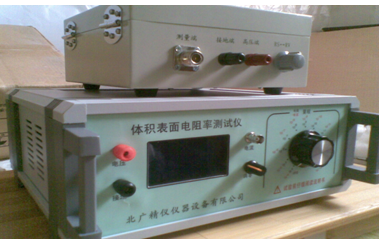
8体积电阻和表面电阻转换
在测试过程中,使用屏蔽箱在进行体积电阻和表面电阻转换时,必须把电源关闭后进行档位转换,否则会导致电压冲击到主机无法显示或损坏。
Usage
1. Connect the power cord properly
Ensure that the power supply is 220VAC/50Hz
2. Connect the power supply
Set the current resistance range to 104 and the voltage range to 10V, and then turn on the device.
3 Zero Adjustment
In the case of an open circuit at both ends of "Rx", zero the ammeter to display 0000 Attention: If there is no open circuit at both ends of "Rx", there will be significant errors in measurement after zeroing when connected to a resistance box or the object being measured. Generally, after one zeroing, there is no need to zero again during the testing process. Shut down after completion.
4 Connection lines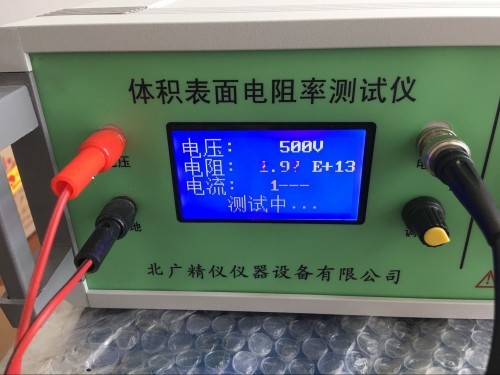
Connect the test line and connect the host to the shielding box. When measuring volume resistance, turn the test button to the Rv side, and when measuring surface resistance, turn the test button to the Rs side. Then turn on the device.
5. Choose the appropriate measurement voltage
The voltage selection switch is located on the back panel. Please note that the measured voltage should not be changed arbitrarily during the testing process, as it may damage the tested device or instrument due to excessive voltage or current;
6 Tests
When measuring, gradually shift from low gear to high gear, pause for 1-2 seconds each time to observe the displayed number. When the measured resistance is greater than the measuring range of the instrument, the resistance meter displays "1". At this time, continue to move the instrument to a higher range position. When the measuring instrument displays a value, stop. The current number multiplied by the level is the measured resistance value. When there are displayed numbers, do not dial higher gears, otherwise the measuring instrument will exceed the range, the internal protection circuit will start working, and the measurement accuracy of the instrument will decrease.
After completing the test, set the resistance current range to "104" and adjust the voltage range to 10V, then turn off the power
The range switch should be turned back to the range position of 104 "zero" for each measurement to avoid damaging the instrument in case of power on or short circuit at the measuring end. 6.8 Measurement of current and measurement of ultra-high resistance above 1015Ω. The method of calculating resistance by dividing voltage by current using Ohm's law after measuring current is detailed in section 8.5.
Conversion between Volume Resistance and Surface Resistance
During the testing process, when using a shielding box to convert volume resistance and surface resistance, the power must be turned off before gear conversion, otherwise it may cause voltage shock to the host and result in inability to display or damage.
表面电阻率surface resistivity
在绝缘材料的表面层里的直流电场强度与线电流密度之商,即单位面积内的表面电阻。面积的大
小是不重要的。
注:表 面 电 阻 率 的S1单 位 是Q。实 际 上 有 时 也 用 “欧 每 平 方 单 位 ”来 表 示 。
技术指标
1. 电阻测量范围:1?104Ω ~1?1018Ω,分为十个量程。
2. 电流测量范围为2?10-4A~1?10-16A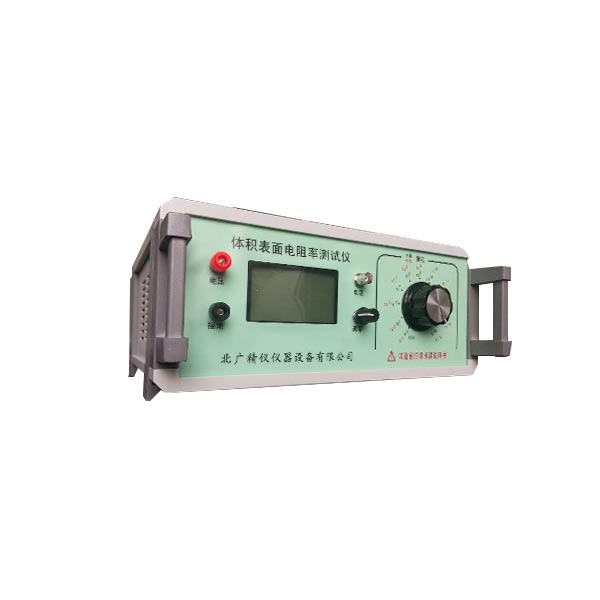
3. 全数字液晶屏显示。
4. 准确度:准确度优于下表
量程有效显示范围20~30℃RH<80%
104 0.01~19.99 5%
105 0.01~19.99 5%
106 0.01~19.99 5%
107 0.01~19.99 5%
108 0.01~19.99 5%
109 0.01~19.99 5%
1010 0.01~19.99 5% 2字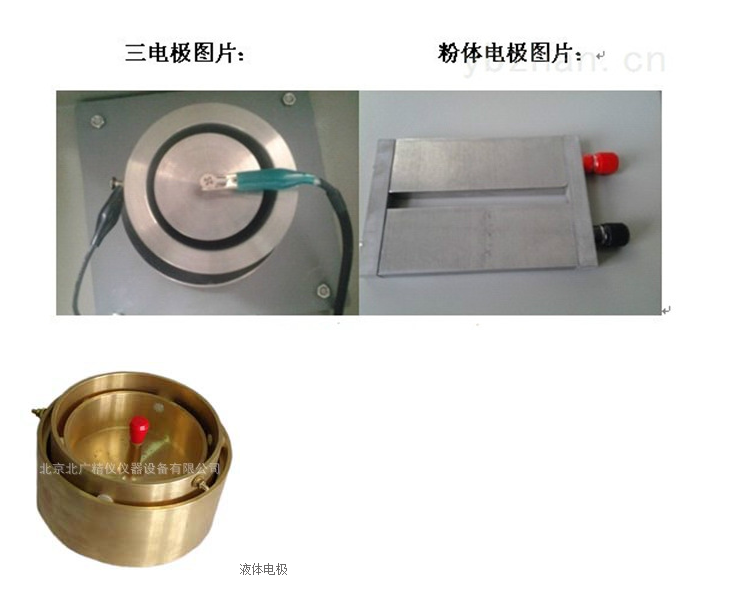
1011 0.01~19.99 5% 2字
1012 0.01~19.99 5% 5字
1013 0.01~19.99 10% 5字
1014 0.01~19.99 10% 5字
1014以上0.01~19.99 10-15% 5字
超出有效显示范围时误差有可能增加,测试电流准确度与电阻相同,测试电压准确度为10%
5.使用环境:温度-10℃~50℃ 相对湿度<90%。
6.测试电压: DC10V、50V、100V、250V、500V、1000V。?10%
7.供电形式: AC 220V,50HZ,功耗约10W。
8.仪器尺寸: 300mm?280mm?150 mm。
9.质量:约3.0KG。
电极electrodes
电极是具有一定形状、尺寸和结构的与被测试样相接触的导体。
注:绝缘电阻是加在与试样相接触的两电极之间的直流电压与通过两电极的总电流之商 绝缘电阻取决于试样的表面电阻和体积电阻(见GB/T 10064-2006)
条件处理
试样的处理条件取决于被试材料,这些条件应在材料规范中规定。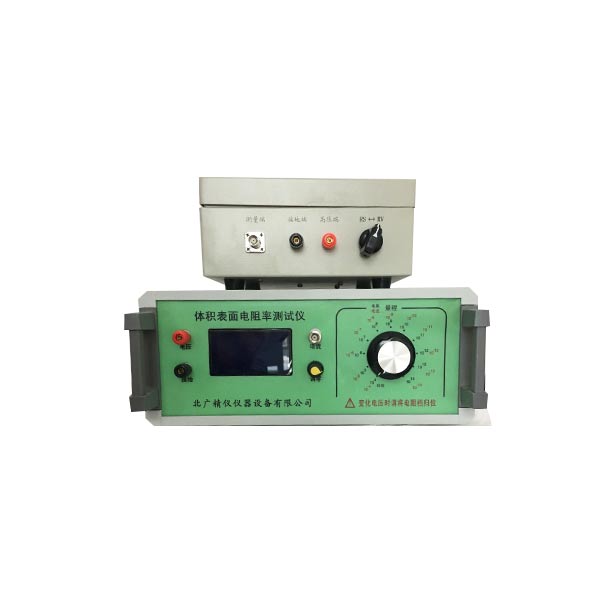
推荐按GB/T 10580一2003进行条件处理;由各种盐溶液所产生的相对温度在IEC 60260中给出。
可以采用机械蒸发系统。
体积电阻率和表面电阻率都对温度变化特别敏感。这种变化是指数式的。因此必须在规定的条件下来测量试样的体积电阻和表面电阻。由于水分被吸收到电介质内是相对缓慢的过程,因此测定温度对体积电阻率的影响需要延长处理期。吸收水分后通常会降低体积电阻。有些试样可能需要处理数月才能达到平衡。
Volume resistivity
Before testing, the sample should be made to have a stable dielectric state. To this end, short-circuit the measuring electrodes 1 and 3 of the sample using a measuring device (Figure la), gradually increase the sensitivity of the current measuring device to meet the requirements, and observe the changes in the short-circuit current. Continue this process until the short-circuit current reaches a relatively constant value, which should be less than the stable value of the electrification current or less than the current for 100 minutes of electrification. Due to the possibility of the short-circuit current changing direction, even if the current is zero, the short-circuit state must be maintained for the required time. When the short-circuit current Io becomes essentially constant (which may take several hours), record the value and direction of Io.
Then add the specified DC voltage well and start timing at the same time. Unless otherwise specified, measurements shall be taken at each of the following electrification times: 1 minute, 2 minutes, 5 minutes, 10 minutes, 50 minutes, 100 minutes. If the same result is obtained from two consecutive measurements, the experiment can be terminated and this current value can be used to calculate the volume resistance. Record the electrification time when the same measurement result is observed. If a stable state cannot be reached within 100 minutes, record the functional relationship between volume resistance and electrification time.
As an acceptance test, according to relevant specifications, a fixed electrochemical time, such as the current value after 1 minute, is used to calculate the volume resistivity.
report
The report should include at least the following information:
a) Description and marking of materials (name, grade, color, manufacturer, etc.) for resistivity tester (resistivity tester);
b) The shape and size of the sample of the resistivity tester (resistivity tester);
c) The form, material, and size of electrodes and protective devices for resistivity testers (resistivity meters);
d) Processing of resistivity tester (resistivity tester) samples (cleaning, pre drying, processing time, humidity, and temperature), etc;
e) Test conditions for resistivity tester (resistivity tester) (sample temperature, relative humidity);
f) Measurement method of resistivity tester (resistivity measuring instrument);
g) Apply voltage to the resistivity tester;
h) Electrical resistivity tester (resistivity tester) body and resistivity (when needed);
Note 1: When a fixed electrification time is specified, indicate this time, provide individual values, and report the median as the volume resistivity.
Note 2: When testing after different electrification times, the following requirements should be reported:
When the sample reaches a stable state elbow within the same electrochemical time, provide individual values and report the median as the volume resistivity. If some samples cannot reach a stable state during this electrification time, report the number of samples that cannot reach a stable state and provide their results separately. When the test results depend on the electrification time, report the relationship between them, for example, in the form of a graph or provide the median volume resistivity after electrification for Imin, 10min, and 100min.
i) Surface resistivity (when needed):
Provide individual values with an electrochemical time of 1 minute and report the value as the surface resistivity.
测试步骤:
1、测试温度23?2℃,相对湿度65?5%,无外界电磁场干扰环境中进行。
2、测试时对试样所加电压为100V~500V的直流电压,选择电压档次。
3、将试样倒入高压电极内,使液面刚好和环电极下缘全部接触为止。
4、将充分放电后的试样和电极,按固体(液体)体积及表面电阻率测试仪要求接线。
外电极(高压电极)接高固体(液体)体积及表面电阻率测试仪的高压输出端。
内电极(测量电极)接固体(液体)体积及表面电阻率测试仪的测量端。
中电极(环电极)接固体(液体)体积及表面电阻率测试仪的接地端。
5、仪器预热30分钟,稳定后调整仪器(调零),加上试验1分钟,读取电阻指示值,然后放电1分钟,再测试一次,以二次的算术平均值作为试验样品电阻指示值。
典型应用
1.硫化橡胶体积、表面电阻率测定
2.测量防静电鞋、导电鞋的电阻值
3.测量防静电材料的电阻及电阻率
4.测量计算机房用活动地板的系统电阻值
5.测量绝缘材料电阻(率)
6.光电二极管暗电流测量
7.物理,光学和材料研究
8.高分子材料表面体积电阻率测定
影响电阻率的外界因素
电阻率不仅与材料种类有关,而且还与温度、压力和磁场等外界因素有关。金属材料在温度不高时,ρ与温度t(℃)的关系是ρt=ρ0(1 at),式中ρt与ρ0分别是t℃和0℃时的电阻率;α是电阻率的温度系数,与材料有关。锰铜的α约为1?10-1/℃(其数值极小),用其制成的电阻器的电阻值在常温范围下随温度变化极小,适合于作标准电阻。已知材料的ρ值随温度而变化的规律后,可制成电阻式温度计来测量温度。半导体材料的α一般是负值且有较大的量值。制成的电阻式温度计具有较高的灵敏度。有些金属(如Nb和Pb)或它们的化合物,当温度降到几K或十几K(绝对温度)时,ρ突然减少到接近零,出现超导现象,超导材料有广泛的应用前景。利用材料的ρ随磁场或所受应力而改变的性质,可制成磁敏电阻或电阻应变片,分别被用来测量磁场或物体所受到的机械应力,在工程上获得广泛应用。
安全注意事项
1.使用前务必详阅此说明书,并遵照指示步骤,依次操作。
2.请勿使用非原厂提供之附件,以免发生危险。
3.进行测试时,本仪器测量端高压输出端上有直流高压输出,严禁人体接触 ,以免触电。
4.为避免测试棒本身绝缘泄漏造成误差,接仪器测量端输入的测试棒应尽可 能悬空,不与外界物体相碰。
5.当被测物绝缘电阻值高,且测量出现指针不稳现象时,可将仪器测量线屏 蔽端夹子接 上。 例如: 对电 缆测缆 芯与 缆壳的 绝缘 时,除 将被 测物两 端分 别接于 输入 端与高压 端, 再将电 缆壳 ,芯之 间的 内层绝 缘物 接仪器 “G”,以消 除因 表面漏 电而 引起的测 量误 差。也 可用 加屏蔽 盒的 方法, 即将 被测物 置于 金属屏 蔽盒 内,接 上测 量线。
preparation:
1. Take 50ml of the tested liquid (such as plasticizer) sample.
2. The sample should be treated for more than 2 hours under the conditions of a temperature of 23?2℃and a relative humidity of 65?5%.
matters needing attention:
1. The measuring electrode must be placed on a highly insulated pad.
2. Before and after testing, the electrodes should be cleaned properly, especially the supporting parts of the three electrodes should not be contaminated by the sample
体积表面电阻率测试仪是一种用于测量材料绝缘性能的精密仪器,广泛应用于多个行业,主要涉及对材料电绝缘性能有严格要求的领域。北京北广精仪仪器设备有限公司声场的体积表面电阻率测试仪主要用于以下主要适用行业及具体应用场景:
1. 电子与半导体行业
应用:测试PCB基板、绝缘薄膜、封装材料、半导体晶圆等的电阻率,确保其绝缘性能满足电子元件防短路、防漏电的要求。
案例:评估手机电路板在高湿度环境下的绝缘可靠性。
2. 电力与能源行业
应用:检测电缆绝缘层、变压器油、复合绝缘子等材料的电阻率,保障高压设备的安全运行。
案例:高压电缆出厂前的绝缘性能验证。
3. 航空航天与汽车制造
应用:评估飞机复合材料、汽车线束、电池隔膜等材料的电绝缘性,防止静电积聚或电磁干扰。
案例:新能源汽车电池组绝缘材料的质量控制。
4. 科研与新材料开发
应用:研究石墨烯、纳米涂层等新型材料的导电/绝缘特性,优化材料配方。
案例:柔性显示技术中透明导电薄膜的研发测试。
5. 医疗设备与生物材料
应用:检测医用塑料、导管、植入材料的绝缘性能,确保患者安全。
案例:心脏起搏器绝缘外壳的生物兼容性测试。
6. 塑料与橡胶工业
应用:质量控制环节中测量工程塑料、硅橡胶等材料的电阻率,用于防静电包装或绝缘部件生产。
案例:防静电托盘用于芯片运输前的电阻率达标测试。
6. 军事与国防
应用:评估隐身涂层、雷达吸波材料等的电学性能。
7 案例:军用无人机复合材料的电磁屏蔽效能测试。
8. 建材与家居行业
应用:检测地板、墙板的防静电性能(如数据中心地板)或绝缘性能(如电工套管)。
案例:洁净室防静电地板的验收测试。
9.能源存储(电池与电容器)
应用:测量隔膜、电解质的电阻率,优化锂电池或超级电容器的性能。
案例:锂电隔膜孔隙率对离子传导性的影响研究。
10. 质量控制与认证机构
应用:作为第三方检测工具,依据ISO/ASTM标准对材料进行认证(如UL认证、RoHS合规性)。
案例:出口电子产品的绝缘安全认证测试。
关键测试参数
体积电阻率(Ω?cm):反映材料内部的绝缘性能。
表面电阻率(Ω/sq):评估材料表面的导电/防静电特性。
行业标准参考
测试常遵循国际标准如IEC 60093、ASTM D257、GB/T 1410等,确保数据可比性。
总之,该仪器是材料电学性能评估的核心设备,覆盖从基础研究到工业生产的全链条需求,尤其在需要高可靠性绝缘或可控导电性的场景中不可或缺。
业务咨询:932174181 媒体合作:2279387437 24小时服务热线:15136468001 盘古机械网 - 全面、科学的机械行业免费发布信息网站 Copyright 2017 PGJXO.COM 豫ICP备12019803号